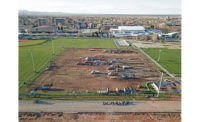Ground Engineering Consultants Inc., an Englewood, Colo.-based firm, provided environmental analysis and geotechnical services for the project and performed a thermal conductivity test on the first well before any subsequent drilling occurred.
From those readings, engineers calculated the ideal size of the loop field based upon the building's energy loads and anticipated trends over time. The final model called for 130 vertical ground loops on 30- by 40-ft minimum centers—which accommodated the placement of the roughly 1,017 structural support caissons needed for the building.
“We ended up with 13 circuits of 10 vertical ground loops each, using a reverse-return supply and return-piping configuration connecting each module to a central manifold pair in the equipment room,” Schmeising says.
The loops were connected to form one continuous loop that circulates a nontoxic antifreeze solution of glycol-based fluid and de-ionized water. The solution absorbs the heat energy from the ground and transfers it to 10 heat pumps located in an interior mechanical room.
A complex control system inside the store directs 10 water-to-water heat pumps, configured in five operating pairs, to transfer the heat energy throughout the various components of the system. Depending upon the need at the moment, the heat energy extracted can be used to provide domestic hot water, heating or cooling through the 26 rooftop air handlers.
Heating And Cooling Loads
“Our cooling load is greater than our heating load,” Wolfe says. “Even in the winter, we will be cooling on some days more than heating just because of the number of co-workers, customers and equipment in the store.”
Rather than re-circulate all excess heat back into the ground loop and risk reducing the efficiency of the geothermal field over time, some of the excess heat is rejected to a heat dissipation loop beneath the customer loading area along the building's north side. The loop—nearly 15 miles of pipe—warms the concrete and serves as an ice melt system during the winter.
A thermal ice storage system in a second mechanical room provides additional cooling as necessary, says Mike Hroncheck of Design Mechanical Inc., Denver, the mechanical contractor for the project. Overnight, the heat pumps produce ice stored in nine 1,200-gallon tanks. The chilled water is then used to supplement the building cooling system during the day.
C&C Automation Co. Inc., San Francisco, wired and programmed the system, which is controlled by a desktop workstation on the upper level.
The cramped site, paired with the complexity of the geothermal system, required extensive pre-planning, says Dwight Slaton, Saunders Construction's senior project manager. “Building information modeling was key to coordinating the mechanical layers and ensuring everything came together as it should,” he adds.
IKEA would not disclose the cost of the installations, nor discuss specifics of the store's energy use, but Joseph Roth, a spokesman for the company, says, “It is all part of our commitment to sustainability, and it will pay for itself.”







